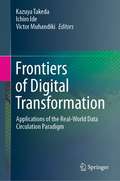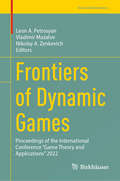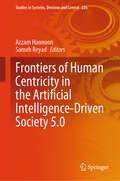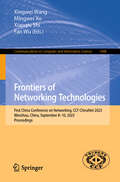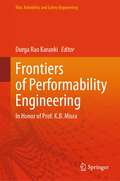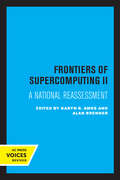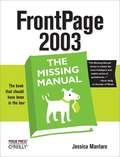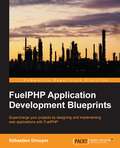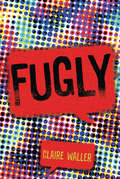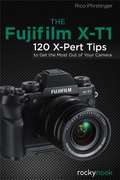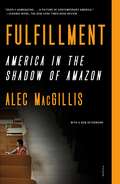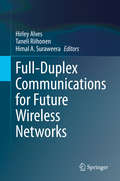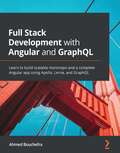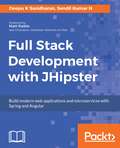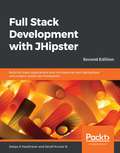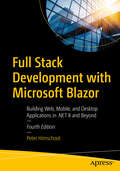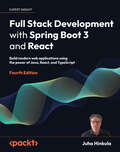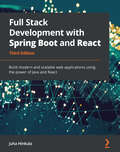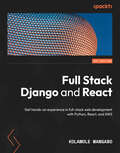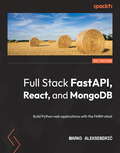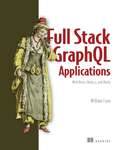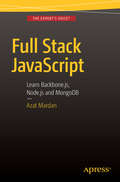- Table View
- List View
Frontiers of Data and Knowledge Management for Convergence of ICT, Healthcare, and Telecommunication Services (EAI/Springer Innovations in Communication and Computing)
by Bo Fu Sara Paiva Suman PaulThis book provides a range of application areas of data and knowledge management and their solutions for the fields related to the convergence of information and communication technology (ICT), healthcare, and telecommunication services. The authors present approaches and case studies in future technological trends and challenges in the aforementioned fields. The book acts as a scholarly forum for researchers both in academia and industry.
Frontiers of Digital Transformation: Applications of the Real-World Data Circulation Paradigm
by Kazuya Takeda Ichiro Ide Victor MuhandikiProposing the concept of real-world data circulation (RWDC), this book presents various practical and industry-related studies in human, mechanical, and social data domains. RWDC is a new field of study, established by the information technology (IT) community.In the real world, the speed of data transmission between computers surpassed that of human communications long ago and has since expanded exponentially. As a result, the origin of the majority of data has become non-human, mechanical, or natural sources; in fact, humans are merely the source of a small part of the current data explosion. Such expanding data transmission does not simply consist of single source–destination pairs, but actually circulates over a complex network connecting numerous sources and destinations. Such circulation is an important aspect of the underlying systems. Based on this concept, in order to tame and control the massive amount of data originating from non-human sources, the authors have been considering the insertion of acquisition, analysis, and implementation processes in the flow of data circulation. This book introduces the outcome of the RWDC degree program organized at Nagoya University, Japan, collecting contributions from graduate students enrolled in the program from various research fields targeting diverse applications. Through examples of RWDC, the resulting creation of social value is illustrated. This book will be useful not only for those working on the topics discussed, but also to anyone who is interested in RWDC, digital transformation, and Industry 4.0.
Frontiers of Dynamic Games: Proceedings of the International Conference “Game Theory and Applications” 2022 (Trends in Mathematics)
by Leon A. Petrosyan Vladimir Mazalov Nikolay A. ZenkevichThis book collects a selection of the articles presented at the virtual conference “Game Theory and Applications”, organized in St. Petersburg in the summer of 2022. The articles in this collection cover all the main applications of game theory, interpolating mathematical methods with economics, biology, sociology, mobile systems, and social networks. Scholars in the field will find this to be a valuable contribution.
Frontiers of Human Centricity in the Artificial Intelligence-Driven Society 5.0 (Studies in Systems, Decision and Control #226)
by Azzam Hannoon Sameh ReyadAccording to Serpa (in MDPI encyclopedia) [3], Society 5.0 can be realized as a concept and a guide for social development, with a profound impact on current societal structures in multiple levels. Society 5.0 achieves advanced convergence between cyberspace and physical space, enabling AI-based on big data and robots to perform or support as an agent the work and adjustments that humans have done up to now. Deguchi et al., [4] define Society 5.0 as a highly intelligent society based on generation, processing, exchange of data, and more specifically knowledge, through the connection of the physical environment with the cyberspace. Achieving Society 5.0 with these attributes would enable the world to realize economic development while solving key social problems. It would additionally contribute to achieving the SDGs established by the United Nations. Despite the differences in formulation of the names of these periods and societies, it is obvious that each of them became a basis for step like growth in developed society; at, specific time periods, scale, character and depth of these changes are different in different countries. Consequently, to address the aims of the book, it seeks exploratory, empirical, interpretive, and theoretical research built on either primary or secondary data. The approaches suggested are not exhaustive and can be extended upon by the researchers. In addition, the book will contribute towards the UN’s sustainable development goals. In support of UN’s efforts towards a more digital economy, this book aims to debate and discuss the history, genesis, future, opportunities, and challenges of transitioning to Society 5.0. and provides a holistic perspective on a variety of topics special topics which contribute towards the optimal attainment of the SDGs, particularly in terms of socialdimensions. Finally, this book provides a platform for researchers, academics, and professionals to the transition and technological enablers of industrial revolutions through empirical or exploratory studies that use a variety of innovative approaches. The target audience of the book includes researchers and scholars who will find in its comprehensive knowledge about industry 4, industry 5, society 5 and its contribution to economic growth and sustainable development goals (SDGs). Furthermore, the book’s secondary target audience are teachers, managers, strategists, professionals, governments, and policymakers.
Frontiers of Networking Technologies: First China Conference on Networking, CCF ChinaNet 2023, Wenzhou, China, September 8–10, 2023, Proceedings (Communications in Computer and Information Science #1988)
by Fan Wu Mingwei Xu Xingwei Wang Xiaoqiu ShiThis book constitutes the proceedings of the First China Conference on Networking, CCF ChinaNet 2023, which took place in Wenzhou, China, during September 8-10, 2023. The 13 full papers included in the book were carefully reviewed and selected from 61 submissions. They deal with networking technologies such as cloud computing; mobile and network security; computer engineering and networks; etc. The theme of this year's conference was “Integrating Industry, Search, and Innovation, Serving the Networking Powerhouse”.
Frontiers of Performability Engineering: In Honor of Prof. K.B. Misra (Risk, Reliability and Safety Engineering)
by Durga Rao KarankiThis book presents recent advances in performability analysis methods and their applications in different fields. It covers various aspects of performability such as quality, reliability, maintainability, availability, safety, security, and sustainability that are essential in complex engineering systems such as electrical grids, chemical plants, naval defense systems, structures, nuclear reactors, railways, etc. This book is a collection of research works contributed by the former students of Professor KB Mishra who is a renowned researcher in reliability engineering. This book is useful for the researchers and professionals working in the area of performability engineering.
Frontiers of Supercomputing II: A National Reassessment (Los Alamos Series in Basic and Applied Sciences #13)
by Karyn R. Ames Alan BrennerThis uniquely comprehensive book brings together the vast amount of technical, economic, and political information and the analyses of supercomputing that have hitherto been buried in the frequently inaccessible "gray literature." Seventy-nine distinguished participants in the second Frontiers of Supercomputing conference offer perceptive and often controversial views on the emerging computing environment in the United States. This title is part of UC Press's Voices Revived program, which commemorates University of California Press’s mission to seek out and cultivate the brightest minds and give them voice, reach, and impact. Drawing on a backlist dating to 1893, Voices Revived makes high-quality, peer-reviewed scholarship accessible once again using print-on-demand technology. This title was originally published in 1994.
FrontPage 2003: The Missing Manual
by Jessica MantaroIn today's highly connected world, almost everybody has a web site, from local sewing circles to the world's largest corporations. If you're ready for one of your own, Microsoft's FrontPage 2003 has everything you need to create Web pages. It's true. Your geek friends may howl in contempt if you use FrontPage, but that's because the program has a reputation for spitting out cookie-cutter Web pages with messy, overloaded HTML code that takes forever to load. Not any more. After listening to complaints, Microsoft has given FrontPage 2003 some pretty advanced features, including an HTML cleanup tool that helps alleviate bloated code, and new support for Macromedia Flash and XML. Now, savvy Web veterans can control as much of the process as they want, and even collaborate on a site with developers who use Dreamweaver, GoLive or other Web authoring tools. Yet, unlike those other tools, FrontPage 2003 still has automated features for beginners who don't know where to start. There's still one flaw, though. Microsoft's idea of a user manual is a flimsy pamphlet. But that's easily solved. FrontPage 2003: The Missing Manual offers you everything from the basics to meaty sections on advanced tasks. Our book puts the program's features in context, with clear and thorough chapters that provide valuable shortcuts, workarounds, and just plain common sense, no matter where you weigh in on the technical scale. With it, you can learn to build simple Web pages, or sophisticated ones with tables and Cascading Style Sheets, and find out how to manage and publish a Web site. You'll also learn to create forms, work with databases, and integrate FrontPage with Microsoft Office. If you haven't worked with Web pages before, each chapter provides "Up to Speed" sidebars with useful background information. If you do have experience, the "Power Users' Clinic" sidebars offer advanced tips and insights. You won't find tips like those in the pamphlet, or even in the Help file. FrontPage: The Missing Manual gives you the complete lowdown on the program above and beyond any book on the market.
The Frugal CISO: Using Innovation and Smart Approaches to Maximize Your Security Posture
by Kerry AndersonIf you're an information security professional today, you are being forced to address growing cyber security threats and ever-evolving compliance requirements, while dealing with stagnant and decreasing budgets. The Frugal CISO: Using Innovation and Smart Approaches to Maximize Your Security Posture describes techniques you can immediately put to u
FuelPHP Application Development Blueprints
by Sebastien DrouyerThis book is for intermediary to seasoned web developers who want to learn how to use the FuelPHP framework and build complex projects using it. You should be familiar with PHP, HTML, CSS, and JavaScript, but no prior knowledge about MVC frameworks is required.
Fugly
by Claire WallerA wrenchingly honest, thought-provoking exploration of a girl judged and dismissed by society who must break the cycle of shaming that traps her in her real life and comforts her in her online one. In real life, eighteen-year-old Beth is overweight, shy, and geeky. She's been bullied all her life, and her only refuge is food. Online, though, she's a vicious troll who targets the beautiful, vain, oversharing It Girls of the internet. When she meets Tori, a fellow troll, she becomes her online girlfriend-slash-partner-in-crime. But then Tori picks a target who's a little too close to home for Beth. Unsettled, Beth decides to quit their online bullying partnership. The only problem is, Tori is not willing to let her go.
The Fujifilm X-E2
by Rico PfirstingerThe Fujifilm X-E2: Beyond the Manual provides experience-based information and insights for owners of the Fujifilm X-E2 mirrorless system camera. Fuji X-Pert series author Rico Pfirstinger teaches little-known capabilities of the X-E2 that he's discovered through several months of in-depth research. This book focuses on insights that you won't find in the manual, skipping tedious explanations of basic camera functions and operations. Instead, it cuts to the chase and provides readers with a plethora of tips and practical instructions that will enable them to fully explore the capabilities of the X-E2.The X-E2 combines classic design with state-of-the-art digital camera technology originally seen in the X-Pro1 and X-E1 system cameras. These features have been further improved to achieve the X-E2: Fujifilm's most capable camera to-date, with an ever-growing set of already more than ten interchangeable X-Mount lenses. The Fujifilm X-E2: Beyond the Manual presents numerous tips and tricks that will maximize your ability to use the Fujifilm X-E2 to its full potential.
Fulfillment: Winning and Losing in One-Click America
by Alec MacGillisA New York Times Book Review Editors' Choice"A grounded and expansive examination of the American economic divide . . . It takes a skillful journalist to weave data and anecdotes together so effectively." —Carolyn Kellogg, Los Angeles TimesAn award-winning journalist investigates Amazon’s impact on the wealth and poverty of towns and cities across the United States.In 1937, the famed writer and activist Upton Sinclair published a novel bearing the subtitle A Story of Ford-America. He blasted the callousness of a company worth “a billion dollars” that underpaid its workers while forcing them to engage in repetitive and sometimes dangerous assembly line labor. Eighty-three years later, the market capitalization of Amazon.com has exceeded one trillion dollars, while the value of the Ford Motor Company hovers around thirty billion. We have, it seems, entered the age of one-click America—and as the coronavirus makes Americans more dependent on online shopping, its sway will only intensify.Alec MacGillis’s Fulfillment is not another inside account or exposé of our most conspicuously dominant company. Rather, it is a literary investigation of the America that falls within that company’s growing shadow. As MacGillis shows, Amazon’s sprawling network of delivery hubs, data centers, and corporate campuses epitomizes a land where winner and loser cities and regions are drifting steadily apart, the civic fabric is unraveling, and work has become increasingly rudimentary and isolated.Ranging across the country, MacGillis tells the stories of those who’ve thrived and struggled to thrive in this rapidly changing environment. In Seattle, high-paid workers in new office towers displace a historic black neighborhood. In suburban Virginia, homeowners try to protect their neighborhood from the environmental impact of a new data center. Meanwhile, in El Paso, small office supply firms seek to weather Amazon’s takeover of government procurement, and in Baltimore a warehouse supplants a fabled steel plant. Fulfillment also shows how Amazon has become a force in Washington, D.C., ushering readers through a revolving door for lobbyists and government contractors and into CEO Jeff Bezos’s lavish Kalorama mansion.With empathy and breadth, MacGillis demonstrates the hidden human costs of the other inequality—not the growing gap between rich and poor, but the gap between the country’s winning and losing regions. The result is an intimate account of contemporary capitalism: its drive to innovate, its dark, pitiless magic, its remaking of America with every click.
Full-Duplex Communications for Future Wireless Networks
by Hirley Alves Taneli Riihonen Himal A. SuraweeraThis book focuses on the multidisciplinary state-of-the-art of full-duplex wireless communications and applications. Moreover, this book contributes with an overview of the fundamentals of full-duplex communications, and introduces the most recent advances in self-interference cancellation from antenna design to digital domain. Moreover, the reader will discover analytical and empirical models to deal with residual self-interference and to assess its effects in various scenarios and applications. Therefore, this is a highly informative and carefully presented book by the leading scientists in the area, providing a comprehensive overview of full-duplex technology from the perspective of various researchers, and research groups worldwide. This book is designed for researchers and professionals working in wireless communications and engineers willing to understand the challenges and solutions full-duplex communication so to implement a full-duplex system.
The Full Stack Developer: Your Essential Guide to the Everyday Skills Expected of a Modern Full Stack Web Developer
by Chris NorthwoodUnderstand the technical foundations, as well as the non-programming skills needed to be a successful full stack web developer. This book reveals the reasons why a truly successful full stack developer does more than write code. You will learn the principles of the topics needed to help a developer new to agile or full stack working—UX, project management, QA, product management, and more— all from the point of view of a developer. Covering these skills alongside the fundamentals and foundations of modern web development, rather than specifics of current technologies and frameworks (which can age quickly), all programming examples are given in the context of the web as it is in 2018. Although you need to feel comfortable working on code at the system, database, API, middleware or user interface level, depending on the task in hand, you also need to be able to deal with the big picture and the little details. The Full Stack Developer recognizes skills beyond the technical, and gives foundational knowledge of the wide set of skills needed in a modern software development team. What You'll LearnPlan your work including Agile vs Waterfall, tools, scrum, kanban and continuous deliveryTranslate UX into code: grids, component libraries and style guidesDesign systems and system architectures (microservices to monoliths)Review patterns for APIs (SOAP, AJAX, REST), defining API domains, patterns for REST APIs and more API goodnessStudy the various front-end design patterns you need to knowStore data, what to consider for security, deployment, in production and more Who This Book Is For New graduates or junior developers who are transitioning to working as part of a larger team structure in a multi-disciplinary teams and developers previously focused on only front-end or back-end dev transitioning into full stack.
Full Stack Development with Angular and GraphQL: Learn to build scalable monorepo and a complete Angular app using Apollo, Lerna, and GraphQL
by Ahmed BouchefraUse tools such as Lerna and GraphQL Code Generator to leverage recent features like NPM Workspaces for configuring a mono-repo project and Apollo Client's reactive variables to easily manage the local state of your appKey FeaturesUse Angular modules and components to build apps that you can easily scale and maintain in the futureDevelop a GraphQL API for a small social network app using Node.js, Express, and Apollo ServerUse Apollo Client to integrate Angular with a GraphQL server and manage your application's local stateBook DescriptionAngular is one of the most popular JavaScript frameworks in modern web app development allowing developers to not only build apps and reuse the code but also develop apps for any deployment target. For web, mobile web, native mobile, and native desktop, GraphQL is the modern and REST alternative for querying web APIs. Using Angular, TypeScript and GraphQL will give you a future-proof and scalable stack you can start building apps around. This book shows you how to build apps using cutting-edge technologies. You'll learn how to solve common web development problems with GraphQL and Apollo, such as database access, authentication, and image uploads. The book starts by introducing you to building full stack apps with Angular and GraphQL. Next, you'll learn how to create a monorepo project with Lerna and NPM Workspaces and configure a Node.js app to use GraphQL with Express and Apollo Server. You'll also understand the basics of Angular architecture and routing. Later, the book demonstrates how to build a professionally-looking UI with Angular Material, use Apollo Client to interface with the server to get data from the built GraphQL API. You'll learn about Apollo Client's type and field policies, and various fetching policies. In addition to this, you'll learn about local state management and reactive variables with Apollo Client and how to generate TypeScript types and even Angular Apollo services for your GraphQL schema and queries using GraphQL Code Generator to implement a scalable codebase. By the end of this book, you'll have the skills you need to be able to build your own full stack application.What you will learnCreate a monorepo project with Lerna and NPM workspacesAdd realtime support with GraphQL subscriptionsBuild a frontend with a modular architecture and Material Design UI components to consume the GraphQL APIUse GraphQL Code Generator to generate types and code for a type-safe and scalable code baseCreate Angular modules and smart and dumb components and share data between themUse Apollo Client features such as client-side queries and reactive variables for local state managementWho this book is forThis Angular GraphQL book is for Angular developers who want to learn how to use GraphQL and Apollo with Angular to build full-stack applications. This book does not assume prior knowledge of full-stack development with Angular and GraphQL.
Full Stack Development with JHipster: Build modern web applications and microservices with Spring and Angular
by Deepu K Sasidharan Sendil Kumar NDiscover the world of Full Stack Development with real-world examples.Key Features Leverage the full power of the JHipster platform to build complex web applications Create microservices from scratch and convert JHipster monolith apps into microservices Build and deploy applications locally, in Docker and on various cloud platforms.Book DescriptionJHipster is a development platform to generate, develop, and deploy Spring Boot and Angular/React applications and Spring microservices. It provides you with a variety of tools that will help you quickly build modern web applications. This book will be your guide to building full stack applications with Spring and Angular using the JHipster tool set.You will begin by understanding what JHipster is and the various tools and technologies associated with it. You will learn the essentials of a full stack developer before getting hands-on and building a monolithic web application with JHipster. From here you will learn the JHipster Domain Language with entity modeling and entity creation using JDL and JDL studio. Moving on, you will be introduced to client side technologies such as Angular and Bootstrap and will delve into technologies such as Spring Security, Spring MVC, and Spring Data. You will learn to build and package apps for production with various deployment options such as Heroku and more. During the course of the book, you will be introduced to microservice server-side technologies and how to break your monolithic application with a database of your choice. Next, the book takes you through cloud deployment with microservices on Docker and Kubernetes. Going forward, you will learn to build your client side with React and master JHipster best practices.By the end of the book, you will be able to leverage the power of the best tools available to build modern web applications.What you will learn Build business logic by creating and developing entity models us the JHipster Domain Language Customize web applications with Angular, Bootstrap and Spring Tests and Continuous Integration with Jenkins Utilize the JHipster microservice stack, which includes Netflix Eureka, Spring Cloud config, HashiCorp Consul, and so on. Understand advanced microservice concepts such as API rout, load balancing, rate limit, circuit break, centralized configuration server, JWT authentication, and more Run microservices locally using Docker and Kubernetes (in production)Who this book is forThis book will appeal to developers who would like to build modern web applications quickly. A basic knowledge of the Spring ecosystem would be an added advantage.
Full Stack Development with JHipster: Build full stack applications and microservices with Spring Boot and modern JavaScript frameworks, 2nd Edition
by Deepu K Sasidharan Sendil Kumar NWritten by the core development team of JHipster and fully updated for JHipster 6, Java 11, and Spring Boot 2.1, this book will show you how to build modern web applications with real-world examples and best practices Key Features Build full stack applications with modern JavaScript frameworks such as Angular, React, and Vue.js Explore the JHipster microservices stack, which includes Spring Cloud, Netflix OSS, and the Elastic Stack Learn advanced local and cloud deployment strategies using Docker and Kubernetes Book Description JHipster is an open source development platform that allows you to easily create web apps and microservices from scratch without spending time on wiring and integrating different technologies. Updated to include JHipster 6, Java 11, Spring Boot 2.1, Vue.js, and Istio, this second edition of Full Stack Development with JHipster will help you build full stack applications and microservices seamlessly. You'll start by understanding JHipster and its associated tools, along with the essentials of full stack development, before building a monolithic web app. You'll then learn the JHipster Domain Language (JDL) with entity modeling using JDL-Studio. With this book, you'll create production-ready web apps using Spring Boot, Spring Framework, Angular, and Bootstrap, and run tests and set up continuous integration pipelines with Jenkins. As you advance, you'll learn how to convert your monoliths to microservices and how to package your application for production with various deployment options, including Heroku and Google Cloud. You'll also learn about Docker and Kubernetes, along with an introduction to the Istio service mesh. Finally, you'll build your client-side with React and Vue.js and discover JHipster's best practices. By the end of the book, you'll be able to leverage the best tools available to build modern web apps. What you will learn Create full stack apps from scratch using the latest features of JHipster 6 and Spring Boot 2.1 Build business logic by creating and developing entity models using JDL Understand how to convert a monolithic architecture into a full-fledged microservices architecture Build and package your apps for production using Docker Deploy your application to Google Cloud with Kubernetes Create continuous integration/continuous delivery pipelines with Jenkins Create applications using Angular, React, and Vue.js client-side frameworks Who this book is for This book is for full stack developers who want to build web applications and microservices speedily without writing a lot of boilerplate code. If you're a backend developer looking to learn full stack development with JavaScript frameworks and libraries such as Angular, React, and Vue.js, you'll find this book useful. Experience in building Java web applications is required. Some exposure to the Spring Framework would be beneficial but not necessary to get the most out of this book.
Full Stack Development with Microsoft Blazor: Building Web, Mobile, and Desktop Applications in .NET 8 and Beyond
by Peter HimschootBecome a full-stack web developer using the Microsoft Blazor framework and the techniques shown in this book. This new edition will have you building all kinds of applications in C# and Microsoft .NET 8, from static web sites to fully interactive single page applications, and desktop and mobile applications, in no time. At it's core, this book teaches you to build user interfaces and present data to a user for display and modification, capturing the user’s changes via data binding. The book shows you how to access a rich library of .NET functionality such as a component modeling for building composable user interfaces—including developing reusable components that can be used across many pages and websites. New for this edition, the book now covers server communication using SignalR and/or gRPC, the use of virtualization to load large quantities of data efficiently, deployment and ahead-of-time compilation into WASM, new unit testing features, security using OpenID Connect, and more features added in Blazor in .NET 8. At it's core, Blazor provides a fresh take on web development by eliminating the need to learn different languages and frameworks for client- and server-side development. It also allows C# and .NET to be used on all sides—both server-side and client-side—providing a robust feature set that is well suited toward scalable, enterprise-level applications. With Blazor you can use all your experience in .NET 8 along with thousands of existing libraries, right in the browser. This book gets you proficient using this important toolkit for web application development. What You Will Learn Build user interfaces and display data for users to edit Capture user edits and changes via data binding Transfer data back and forth between server and client Communicate with services using REST, SignalR, or gRPC Develop reusable components and assemble them into bigger components Use routing to build single-page applications (SPAs) Build stable and maintainable software using unit testing Internationalize your application to reach more users Secure your Blazor application with OpenID Connect Build static interactive pages web pages optimized for SEO Use the same components to build mobile and desktop applications Who This Book is For Experienced .NET developers who want to apply their existing skills toward building professional-quality and server- or client-side web applications that run in any browser; also for web developers who want to step away from JavaScript and its complexities, and instead apply a proven technology (C# and .NET8) that is robust toward creating enterprise-quality applications that scale and are reliable and provide a good user experience
Full Stack Development with Spring Boot 3 and React: Build modern web applications using the power of Java, React, and TypeScript
by Juha HinkulaGet up and running with the Spring Boot and React stack – build an app from start to finish, test the frontend and backend, and deploy. Now with TypeScript code! Purchase of the print or Kindle book includes a free PDF eBookKey FeaturesUse Spring Boot 3 to create powerful, complex, and secure backends for your applicationsLeverage React to build slick, high-performance frontendsGet introduced to TypeScript, Vite, and React Query for React developmentBook DescriptionIf you’re an existing Java developer who wants to go full stack or pick up another frontend framework, this book is your concise introduction to React. In this three-part build-along, you’ll create a robust Spring Boot backend, a React frontend, and then deploy them together. This new edition is updated to Spring Boot 3 and includes expanded content on security and testing. For the first time ever, it also covers React development with the in-demand TypeScript. You’ll explore the elements that go into creating a REST API and testing, securing, and deploying your applications. You’ll learn about custom Hooks, third-party components, and MUI. By the end of this book, you'll be able to build a full stack application using the latest tools and modern best practices.What you will learnMake fast and RESTful web services powered by Spring Data RESTCreate and manage databases using ORM, JPA, Hibernate, and moreExplore the use of unit tests and JWTs with Spring SecurityEmploy React Hooks, props, states, and more to create your frontendHarness the Material UI component library to customize your frontendUse the fetch API, Axios, and React Query for networkingAdd CRUD functionality to your appsDeploy your apps using AWS and DockerWho this book is forThis book is for Java developers who have basic familiarity with Spring Boot but don’t know where to start when it comes to building full stack applications. Basic knowledge of JavaScript and HTML will help you to follow along. You'll also find this book useful if you're a frontend developer with knowledge of JavaScript basics and looking to learn full stack development, or a full stack developer experienced in other technology stacks looking to learn a new one.
Full Stack Development with Spring Boot and React: Build modern and scalable web applications using the power of Java and React, 3rd Edition
by Juha HinkulaDiscover the secrets to creating cutting-edge, compelling full stack applications using Spring Boot and React's rich and varied toolsetsKey FeaturesUtilize Spring Boot to make powerful, complex, and secure backends for your applicationsLeverage React's full arsenal of tools for building slick, high-performance frontendsBuild modern, scalable full stack applications that comfortably meet the demands of your usersBook DescriptionGetting started with full stack development can be daunting. Even developers who are familiar with the best tools, such as Spring Boot and React, can struggle to nail the basics, let alone master the more advanced elements. If you're one of these developers, this comprehensive guide covers everything you need!This updated edition of the Full Stack Development with Spring Boot 2 and React book will take you from novice to proficient in this expansive domain. Taking a practical approach, this book will first walk you through the latest Spring Boot features for creating a robust backend, covering everything from setting up the environment and dependency injection to security and testing.Once this has been covered, you'll advance to React frontend programming. If you've ever wondered about custom Hooks, third-party components, and MUI, this book will demystify all that and much more. You'll explore everything that goes into developing, testing, securing, and deploying your applications using all the latest tools from Spring Boot, React, and other cutting-edge technologies.By the end of this book, you'll not only have learned the theory of building modern full stack applications but also have developed valuable skills that add value in any setting.What you will learnMake fast and RESTful web services powered by Spring Data RESTCreate and manage databases using ORM, JPA, Hibernate, and moreExplore the use of unit tests and JWTs with Spring SecurityEmploy React Hooks, props, states, and more to create your frontendDiscover a wide array of advanced React and third-party componentsBuild high-performance applications complete with CRUD functionalityHarness MUI to customize your frontendTest, secure, and deploy your applications with high efficiencyWho this book is forThis book is for Java developers who are familiar with Spring Boot but don't know where to start when it comes to building full stack applications. You'll also find this book useful if you're a frontend developer with knowledge of JavaScript basics looking to learn full stack development or a full stack developer experienced in other technology stacks looking to learn a new one.
Full Stack Django and React: Get hands-on experience in full-stack web development with Python, React, and AWS
by Kolawole MangaboBuild professional, cloud-ready web applications from frontend to backend using the latest features of Django and ReactKey FeaturesExplore the advanced features of – popular frameworks like Django and React by working on hands-on projectsLaunch your career as a full-stack Python web developer with this step-by-step guideLearn to deploy complete web applications to AWSBook DescriptionDjango developers often need to rely on frontend developers to build a client-side solution for their web apps. By combining the capabilities of React with Django, this book creates a complete learning path to go from being a backend developer to a full stack developer in no time. This book will help you use React to build state-of-the-art UI layouts and Django to create an immaculate backend.This web development book will help you discover the full potential of combining the dual power of the two most popular frameworks – React and Django. You'll build full stack applications, including a RESTful API in the backend and an intuitive frontend, while exploring the advanced features of both frameworks. You'll also explore how the dynamic functionality of the React framework can be used to build your frontend systems and how the ORM layer of Django helps in simplifying database interactions. This will in turn boost the development process for building the backend and facilitate the building of full stack applications.By the end of the book, you will be able to create a dynamic full stack app starting from scratch on your own.What you will learnExplore how things work differently under the hood in the frontend as well as the backendDiscover how to build an API with DjangoStart from scratch to build an intuitive UI using React's capabilitiesDockerize and prepare projects for deploymentDeploy an API and UI using AWS services such as AWS EC2, S3, and AWS CloudfrontWho this book is forThis book is for Django web developers who want to get started with full-stack development and learn a frontend framework that can be quickly bootstrapped with the backend to build full-stack applications. Familiarity to React and JavaScript would be an added advantage.
Full Stack FastAPI, React, and MongoDB: Build Python web applications with the FARM stack
by Marko AleksendricWield the power of Python, React, and MongoDB to build web and data applications quickly and broaden your web development horizonsKey FeaturesLearn how to build web applications without having to know the intricacies of the componentsBuild full stack projects without compromising on development speed and app performancePrepare yourself for the diverse world of web development, analytics, and data visualizationBook DescriptionIf you need to develop web applications quickly, where do you turn? Enter the FARM stack. The FARM stack combines the power of the Python ecosystem with REST and MongoDB and makes building web applications easy and fast.This book is a fast-paced, concise, and hands-on beginner's guide that will equip you with the skills you need to quickly build web applications by diving just deep enough into the intricacies of the stack's components.The book quickly introduces each element of the stack and then helps you merge them to build a medium-sized web application. You'll set up a document store with MongoDB, build a simple API with FastAPI, and create an application with React. Security is crucial on the web, so you'll learn about authentication and authorization with JSON Web Tokens. You'll also understand how to optimize images, cache responses with Redis, and add additional features to your application as well as explore tips, tricks, and best practices to make your development experience a breeze. Before you know it, you'll be deploying the application to different platforms.By the end of this book, you will have built a couple of functional applications efficiently and will have the springboard you need to delve into diverse and more specialized domains.What you will learnDiscover the flexibility of the FARM stackImplement complete JWT authentication with FastAPIExplore the various Python drivers for MongoDBDiscover the problems that React libraries solveBuild simple and medium web applications with the FARM stackDive into server-side rendering with Next.jsDeploy your app with Heroku, Vercel, Ubuntu Server and NetlifyUnderstand how to deploy and cache a FastAPI backendWho this book is forThis book is for web developers and analysts who want to include the power of a modern asynchronous Python framework, a flexible data store and a powerful UI library with the combination of two of the most important programming languages today in their web development toolkit. Beginners in the field of information presentation will also find this book helpful. You must have a beginner-level understanding of Python, JavaScript, and HTML and CSS to get the most out of this book.
Full Stack GraphQL Applications: With React, Node.js, and Neo4j
by William LyonBuild hyper-fast and hyper-efficient web applications with GraphQL! This practical, comprehensive guide introduces the powerful GRANDStack for developing full stack web applications based in graph data structures.In Full Stack GraphQL Applications you will learn how to: Build backend functionalities for GraphQL applications Model a GraphQL API with GraphQL type definitions Utilize Neo4j as a backend database Handle authentication and authorization with GraphQL Implement pagination and rate limiting in a GraphQL API Develop a GraphQL service with Apollo Server Install Neo4j Database on different platforms Create a basic frontend application using React and Apollo Client Deploy a full stack GraphQL application to the cloud The GraphQL query language radically reduces over-fetching or under-fetching of data by constructing precise graph-based data requests. In Full Stack GraphQL Applications you&’ll learn how to build graph-aware web applications that take full advantage of GraphQL&’s amazing efficiency. Neo4j&’s William Lyon teaches you everything you need to know to design, deploy, and maintain a GraphQL API from scratch. He reveals how you can build your web apps with GraphQL, React, Apollo, and Neo4j Database, aka &“the GRANDstack,&” to get maximum performance out of GraphQL. About the technology The GraphQL API query language radically streamlines data exchanges with backend servers by representing application data as easy-to-understand graphs. You can amplify GraphQL&’s benefits by using graph-aware tools and data stores, like React, Apollo, and Neo4j, throughout your application. A full stack graph approach provides a consistent data model end to end, reducing friction in data fetching and increasing developer productivity. About the book Full Stack GraphQL Applications teaches you to build graph-aware web applications using GraphQL, React, Apollo, and the Neo4j database, collectively called &“the GRANDstack.&” Practical, hands-on examples quickly develop your understanding of how the GRANDstack fits together. As you go, you&’ll create and deploy to the cloud a full-featured web application that includes search, authentication, and more. Soon, you&’ll be ready to deploy end-to-end applications that take full advantage of GraphQL&’s outstanding performance. What's inside Building a GraphQL backend using Neo4j Authentication and authorization with GraphQL Pagination and GraphQL abstract types A basic frontend application using React and Apollo Client Deploying to the cloud with Netlify, AWS Lambda, Auth0, and Neo4j Aura About the reader For full stack web developers. No experience with GraphQL or graph databases required. About the author William Lyon is a Staff Developer Advocate at Neo4j and blogger at lyonwj.com. Table of Contents PART 1 GETTING STARTED WITH FULL STACK GRAPHQL 1 What is full stack GraphQL? 2 Graph thinking with GraphQL 3 Graphs in the database 4 The Neo4j GraphQL Library PART 2 BUILDING THE FRONTEND 5 Building user interfaces with React 6 Client-side GraphQL with React and Apollo Client PART 3 FULL STACK CONSIDERATIONS 7 Adding authorization and authentication 8 Deploying our full stack GraphQL application 9 Advanced GraphQL considerations
Full Stack JavaScript
by Azat MardanThis is a hands-on book which introduces you to agile JavaScript web and mobile software development using the latest cutting-edge front-end and back-end technologies including: Node. js, MongoDB, Backbone. js, Parse. com, Heroku, and Windows Azure. Practical examples include building multiple versions of the Chat app: jQuery + Parse. com JS REST API Backbone and Parse. com JS SDK Backbone and Node. js Backbone and Node. js + MongoDB The Chat application has all the foundation of a typical web/mobile application: fetching data, displaying it, submitting new data. Other examples in the book are as follows: jQuery + Twitter RESP API "Tweet Analyzer" Parse. com "Save John" MongoDB "Print Collections" Backbone. js "Apple Database" Monk + Express. js "REST API Server" This book will save you many hours by providing a hand-picked and tested collection of quick start guides. RPJS has practical examples that allow to spend less time learning and more time building your own applications. Prototype fast and ship code that matters! What you''ll learn You should expect a basic understanding from a collection of quick start guides, tutorials and suggestions for the devel0pment apps discussed in this book. In addition to coding examples, the book covers virtually all setup and deployment step-by-step. You''ll learn from the examples of Chat web/mobile applications starting with front-end components and by the end we''ll put front-end and back-end together and deploy to the production environment. Who this book is for The typical programmer who wants to learn more about effective JavaScript coding. Table of Contents I Quick Start 1 Basics 2 Setup II Front-End Prototyping 3 jQuery and Parse. com 4 Intro to Backbone. js 5 Backbone. js and Parse. com III Back-End Prototyping 6 Node. js and MongoDB 7 Putting It All Together 8 Advanced Node. js Topics 9 Conclusion and Further Reading

